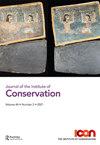19世纪的玻璃制造及其对照相玻璃稳定性的影响
IF 1
0 HUMANITIES, MULTIDISCIPLINARY
引用次数: 2
摘要
工业革命导致了许多材料的大规模生产,这些材料自然地成为了19世纪的文化遗产。其中一种材料是平板玻璃,它的制造经历了一系列的创新,影响了新兴的摄影领域。历史研究的结果说明了玻璃工业的变化如何促成了19世纪摄影师可用的玻璃的多样性,无论是作为外壳的覆盖玻璃还是作为基材。这一信息为仅使用显微镜和x射线荧光(XRF)对两个历史学会收藏的19世纪摄影玻璃进行有限调查提供了重要的背景。调查结果,再加上显微镜、XRF、OCT以及对历史和人工老化模型玻璃的分析,为历史摄影收藏中的玻璃不稳定性提供了新的证据,并强调了任何类型的19世纪玻璃在不利的微气候下经历包括对硅酸盐网络攻击在内的渐进式劣化的可能性。结果对收集需求的优先排序和保护实践都有影响。本文章由计算机程序翻译,如有差异,请以英文原文为准。
Nineteenth century glass manufacture and its effect on photographic glass stability
Abstract The Industrial Revolution led to mass production of many materials that naturally found their way into nineteenth century cultural heritage. One such material is flat glass, the manufacture of which underwent a succession of innovations that influenced the burgeoning field of photography. Results of historical research illustrate how changes in the glass industry contributed to the diversity of glass available to nineteenth century photographers either as cover glass in enclosures or as substrates. This information provides important context for limited surveys of nineteenth century photographic glass in two historical society collections using only microscopy and X-ray fluorescence (XRF). Survey results, plus microscopy, XRF, and OCT and analysis of historical and artificially aged model glass, provide new evidence about instability in glass in historical collections of photography, and underscore the potential for any type of nineteenth century glass to undergo progressive deterioration involving attack on the silicate network in adverse microclimates. Results have implications for both prioritisation of collection needs and conservation practices.
求助全文
通过发布文献求助,成功后即可免费获取论文全文。
去求助
来源期刊

Journal of the Institute of Conservation
HUMANITIES, MULTIDISCIPLINARY-
CiteScore
1.50
自引率
0.00%
发文量
22
期刊介绍:
The Journal of the Institute of Conservation is the peer reviewed publication of the Institute of Conservation (Icon). As such, its aims reflect those of Icon, to advance knowledge and education in conservation and achieve the long term preservation and conservation of moveable and immoveable cultural heritage. The Journal provides a collective identity for conservators; it promotes and supports both the profession and professionalism. With international contributions on all aspects of conservation, it is an invaluable resource for the heritage sector. The specific aims of the Journal are to: 1. promote research, knowledge and understanding of cultural heritage conservation through its history, practice and theory 2. provide an international forum to enable and disseminate advances in research, knowledge and understanding relating to conservation and heritage 3. champion and support professional standards of heritage conservation in the UK and internationally 4. provide a permanent record of issues relating to conservation and heritage 5. be financially and operationally sustainable. To achieve these aims, the Journal invites contributions from all those involved in the conservation of cultural heritage and related activities. Areas of interest include understanding cultural heritage materials and their degradation; subject reviews and histories of cultural heritage materials and conservation treatments; new, innovative or improved approaches to conservation and collections care theory, practice, communication, management and training; case studies demonstrating new, innovative or improved approaches; and conservation in its wider context. Submitters are encouraged to demonstrate how their work is of practical application to conservation. To maintain professional standards and promote academic rigour, submissions of articles and shorter notices are subject to an anonymous peer review process.
 求助内容:
求助内容: 应助结果提醒方式:
应助结果提醒方式:


